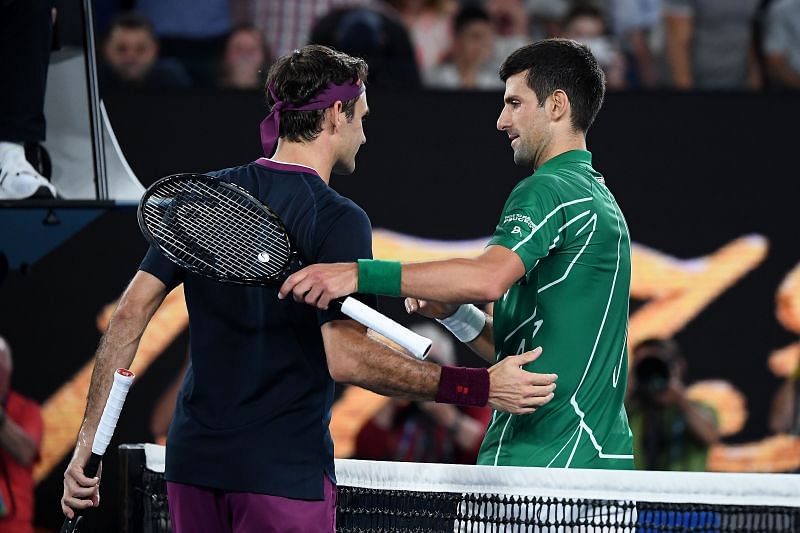
When Roger Federer, Rafael Nadal and Novak Djokovic enter the same tournament, who wins the most often?
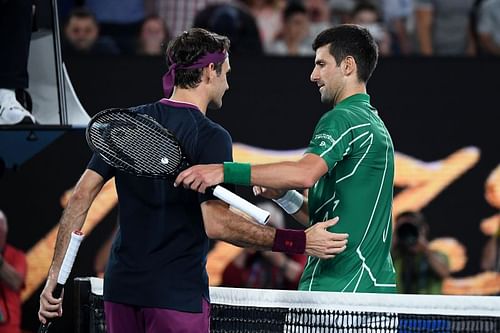
Novak Djokovic won his sixth Wimbledon title and 20th Grand Slam overall earlier this month. With the win, the Serb joined long-time rivals Roger Federer and Rafael Nadal at the top of the Grand Slam leaderboard. At 34 years and 50 days old, the Serb is the youngest of the trio to have reached the 20-Major landmark.
The gap separating the Big 3 from each other is seemingly diminishing with every passing day. But considering Djokovic's recent dominance and the fact that his physical powers are not waning, he could pull away from Federer and Nadal in the coming years.
An analysis of career points obtained by the Big 3 at the conclusion of Roland Garros 2021 showed how Federer led at almost every level, while Novak Djokovic had the best distribution for every result south of 1300 points.
In this study, the same scaled set of career points has been used to measure the performance of the Big 3 in the presence of each other using a metric called the 'tournament head-to-head'.
What is tournament head-to-head and why has it been devised?
The tournament head-to-head between two players can be used to determine who has fared better in tournaments that have featured both of them.
In an event that features two given players, the 'better' performer is the one who advances further (or wins the title, for that matter). The 'better' performer is given a 'win' while the other is marked with a 'loss'. If both players involved achieve a similar result, they are said to have 'tied'.
We are all familiar with the basic records of the Big 3 and how they have fared against one another overall. But how many times have two members of the elite trio taken part in the same tournament, and how have they performed on such occasions?
As was the case with previous studies on the GOAT race, performances from team competitions have not been considered.
Roger Federer-Novak Djokovic tournament head-to-head from Bangkok 2004 to Wimbledon 2021
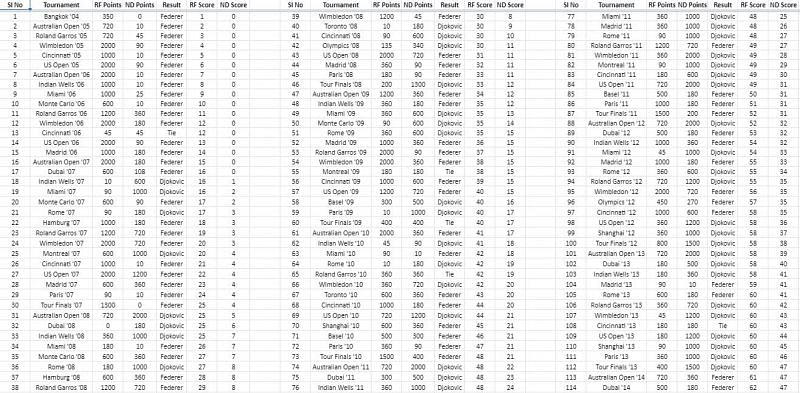
Roger Federer and Novak Djokovic featured in a tournament together for the first time at the 2004 Bangkok Open - when they were 23 and 17 years of age respectively. Federer was World No. 1 at the time and ended up winning the tournament, while Djokovic suffered an opening-round exit.
At Indian Wells in 2007 was the first time Djokovic earned a better result than Federer when the two took part in the same event. By then, Federer had opened up a 16-0 lead. The Swiss lost out in the second round at Indian Wells, while Djokovic went on to make the finals.
The Serb backed up that run by winning the very next tournament in Miami. It marked the first instance Djokovic won a tournament in which Federer was present.
By the end of 2010, the pair had jointly featured in 73 tournaments, with Federer leading the head-to-head 48-21 -- the biggest margin observed in the rivalry to date.
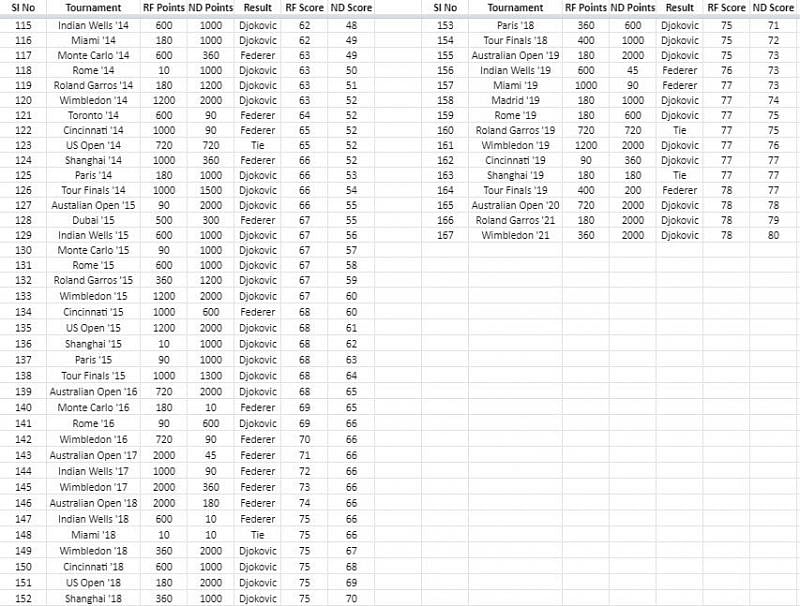
2011 marked the start of the 'Djokovic era', with the Serb beginning to gain ground on the Swiss. Roland Garros 2011 was the first tournament in the 'Djokovic era' in which Federer recorded a better performance than the Serb, while Basel 2011 marked the time the Swiss won a tournament while Djokovic was in the draw.
By the end of Rome 2016, Djokovic had narrowed the gap to just three (69-66).
But, the Swiss then notched up six 'wins' on the trot, before Djokovic broke that run at Wimbledon in 2018. The Serb then registered seven straight 'wins' - his longest such streak over Federer. He finally drew level at the conclusion of the 2020 Australian Open with the pair boasting 78 wins apiece.
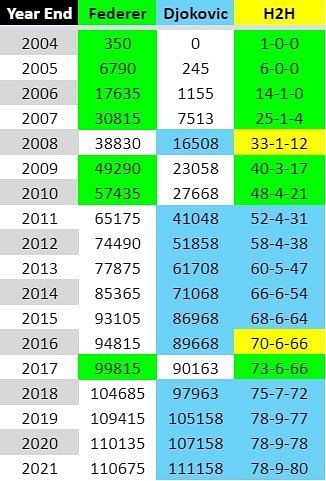
By winning Roland Garros and Wimbledon this year, Djokovic has established a lead in the rivalry for the first time. The record currently stands at 80-78 in favor of the Serb, with nine ties.
Cumulatively from all these tournaments, Federer has scored 110,675 points while Djokovic has amassed 111,158.
Federer-Nadal tournament head-to-head from Hamburg 2003 to Roland Garros 2021
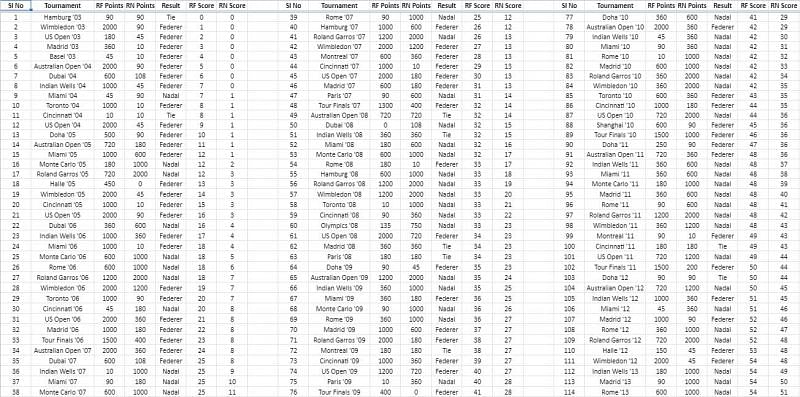
Roger Federer and Rafael Nadal appeared together in a tournament for the first time in Hamburg in 2003. At the time, Federer was aged 21 while Nadal was just 16 years old. Both players were eliminated in the third round.
A couple of months later, the Swiss lifted his first Grand Slam title at Wimbledon. Incidentally, it was the Swiss' first victory in a tournament that also featured Nadal.
Federer then achieved a better result than Nadal in every tournament until Indian Wells in 2004, opening up a 7-0 lead in the tournament head-to-head. Miami 2004 was the first tournament in which Nadal outperformed the Swiss. The Spaniard reached the third round, beating Federer en route.
The first time Nadal won a tournament in which Federer was present was in Monte-Carlo the following year.
By the end of 2007, the Swiss had built up a 32-14 lead -- the greatest difference observed in the rivalry to date. In 2008, Nadal ascended to World No. 1 for the first time in his career. His rise was reflected in the tournament head-to-head as he led 9-2 that season, with four tied results.
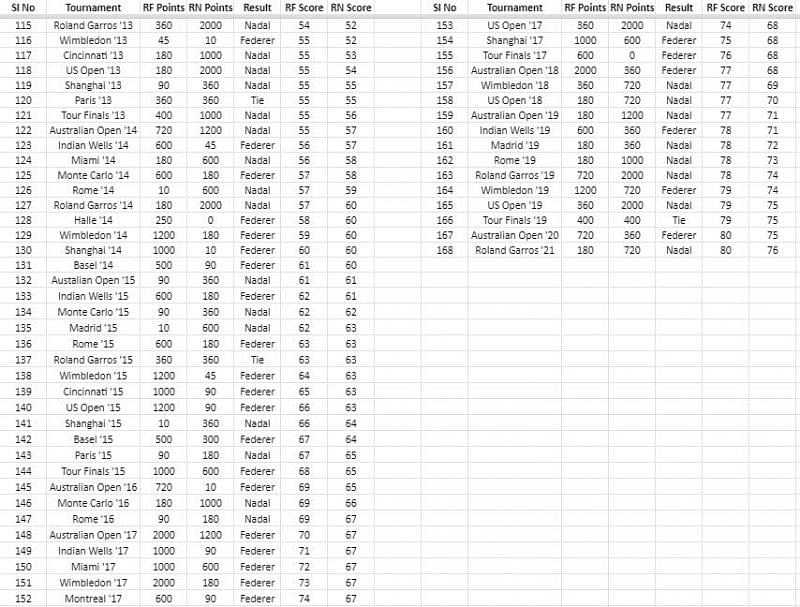
But unlike the Federer-Djokovic rivalry, where there was a distinct divide between the two eras, the rivalry between Nadal and the Swiss has been much more uniform. In 2011, the Spaniard recorded seven 'wins' on the trot from Indian Wells to Wimbledon - his longest streak over Federer.
Following the ATP Tour Finals in 2013, Nadal led Federer for the first time in the tournament head-to-head - 56-55. After Roland Garros 2014, the score read 60-57 in Nadal's favor - the biggest margin by which the Spaniard has led.
Federer regained his lead in 2015 and has held on to it ever since.
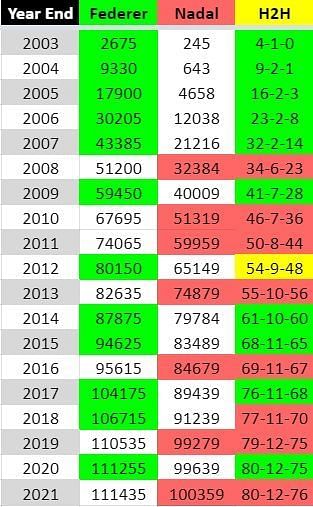
Roland Garros 2021 was the 168th tournament that featured both Nadal and Federer. The Swiss currently leads the rivalry 80-76, with 12 ties.
Federer has accumulated 111,435 points from these tournaments, while Nadal has amassed 100,359.
Nadal-Djokovic tournament head-to-head from Australian Open 2005 to Roland Garros 2021
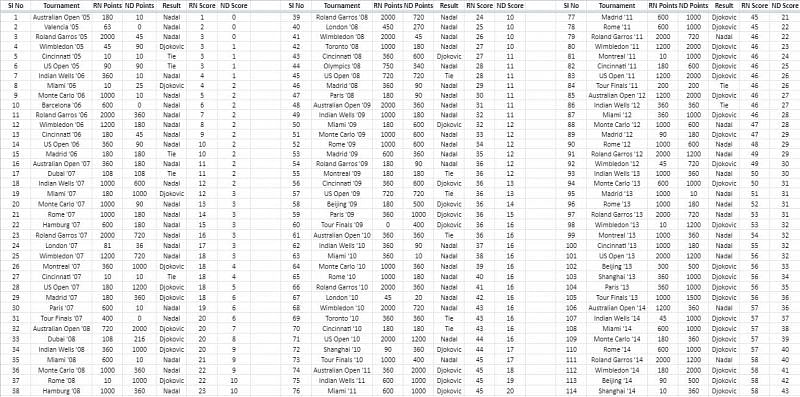
Rafael Nadal and Novak Djokovic jointly featured in a tournament for the first time in the Australian Open in 2005 - when they were 18 and 17 years of age respectively. Nadal reached the Round of 16, while Djokovic lost in the first round.
A few months later, Nadal won his first Grand Slam at Roland Garros, which also happened to be his first title at a tournament that featured Djokovic. At this point, Nadal led the tournament head-to-head 3-0. However, the Serb outperformed Nadal in the very next tournament -- Wimbledon 2005. The Spaniard lost in the second round while Djokovic made the third.
In 2007, Djokovic beat Nadal in the quarterfinals of Miami and went on to lift the trophy. It was Djokovic's first title at a tournament that featured the Spaniard in the draw. As stated earlier, it was also his first title in Federer's presence.
Like Federer, Nadal also established a hefty lead over Djokovic in the first half of their rivalry. In 2010, the Spaniard went 8-0 from Indian Wells to the US Open (with two tied results) - his longest win-streak against Djokovic. By the end of the year, he led 45-17 - the biggest difference observed in the rivalry to date.
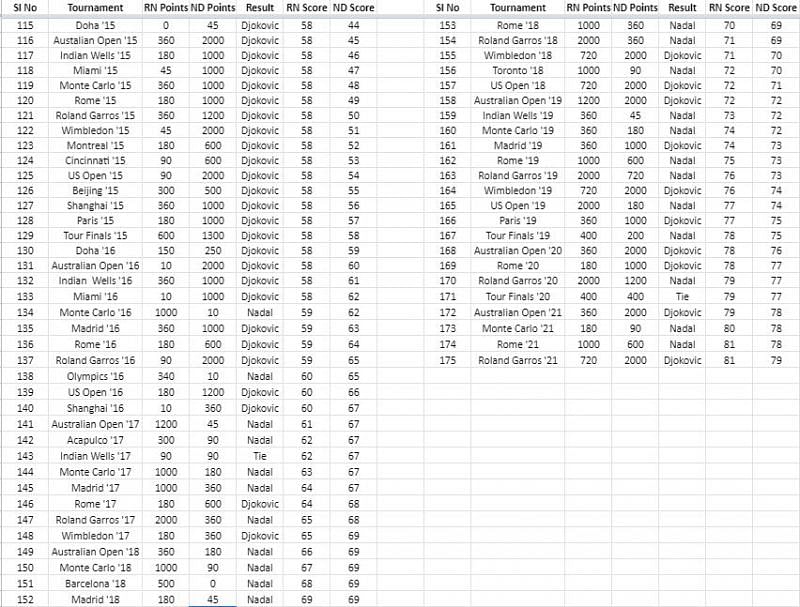
In 2011, Djokovic established his dominance in the rivalry for the first time as he went 9-1. But the most telling moment of the rivalry came following Nadal's win at Roland Garros 2014. From Wimbledon that year to Miami in 2016, Djokovic went 22-0 over Nadal.
In the process, he turned the head-to-head in his favor. The Serb extended his lead over the remainder of the year and ended 2016 leading 67-60.
But Nadal started to gain ground once the 2017 season began. At the end of Rome in 2018, he had regained his lead -- 70-69 -- and has held on to it to date.
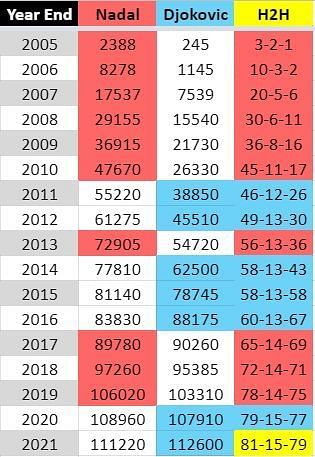
Including Roland Garros 2021, Nadal and Djokovic have featured together in 175 tournaments. The Spaniard leads the tournament head-to-head 81-79, with 15 tied results.
However, when it comes to points earned from the events, Djokovic has a healthy lead. The Serb has collected 112,600 points while Nadal has managed 111,220.
Federer-Nadal-Djokovic tournament head-to-head from Australian Open 2005 to Roland Garros 2021
While the previous tables compare the results of any two members of the Big 3 in the same tournament, they do not shed light on how each of them has fared when both of their rivals have been in the draw. That is explained below:
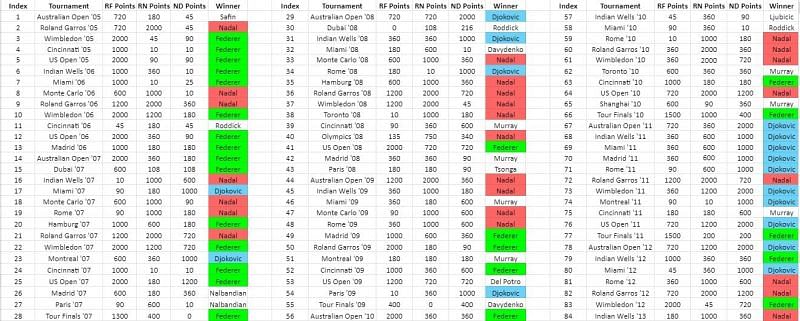
From Australian Open 2005 to Roland Garros 2021, Roger Federer, Rafael Nadal and Novak Djokovic have featured together in 131 tournaments.
Federer has performed uniquely best in 38 tournaments and jointly in five. He has collected 31 titles in the process and scored 88,975 points. His average performance rank is calculated to be 2.06.
Nadal has performed uniquely best in 41 tournaments and jointly in four events. He has collected 35 titles in the process and scored 88,696 points. His average performance rank is calculated to be 1.96.
Djokovic has performed uniquely best in 47 tournaments and jointly in two. He has collected 40 titles in the process and scored 90,339 points. His average performance rank is calculated to be 1.98.
Note: Joint best implies two or more players jointly achieved the best result at a given tournament. For eg: In Montreal 2009, Djokovic, Federer and Nadal all achieved the same result -- a quarterfinal finish.
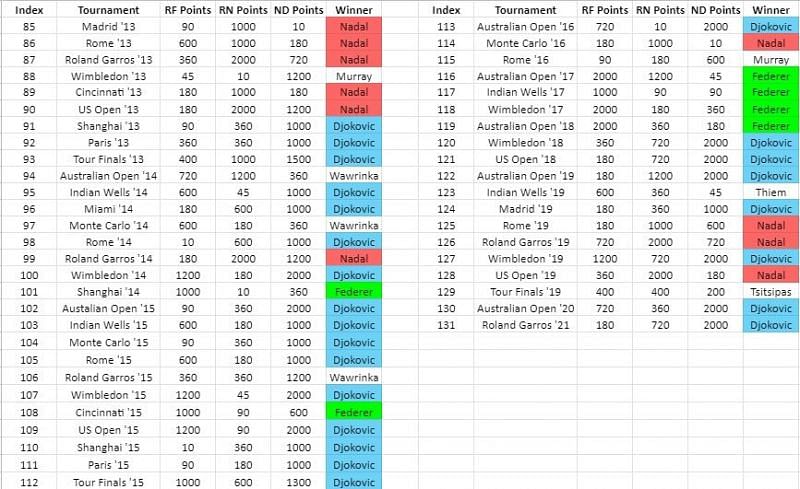
So far, 106 of the 131 tournaments that have featured the trio have been won by one of them. Out of the remaining 26, Andy Murray has won nine, Andy Roddick and Stan Wawrinka have won three each.
David Nalbandian and Nikolay Davydenko have won two apiece, while Marat Safin, Jo-Wilfried Tsonga, Juan Martin del Potro, Ivan Ljubicic, Dominic Thiem and Stefanos Tsitsipas have won one each.
The conclusion, or is there one?
Novak Djokovic has collected the most silverware and points among the Big 3 across the intersection of their timelines.
Rafael Nadal has the highest average performance ranking from tournaments that have featured all three of them.
Meanwhile, Roger Federer has a decisive advantage in terms of points in his tournament head-to-head against Nadal. He is almost equal to Djokovic in this statistic despite a major chunk of their rivalry occurring during the Serb's prime.
Rather than highlighting any significant differences between the three players, the study shows just how evenly matched the trio are. More importantly, it shows the degree to which their careers have overlapped.
It is important to note that this study does not undermine what the three players have achieved in the absence of one another. While the tournament head-to-head might be a good way to gauge the relative performances of two (or more) players in a given draw, it does not shed light on plenty of other aspects of their careers.